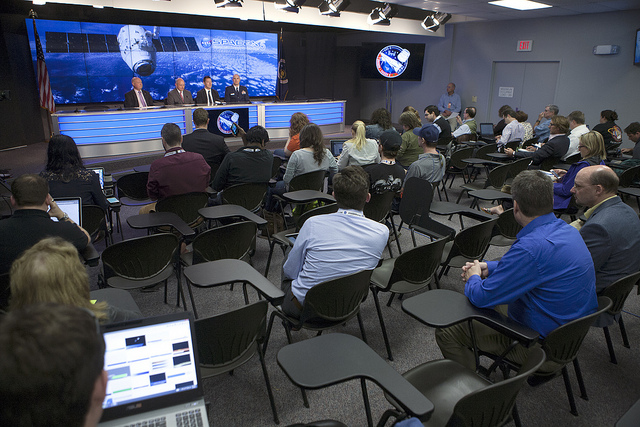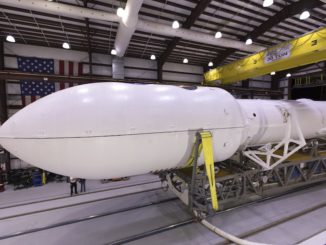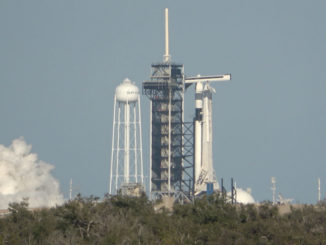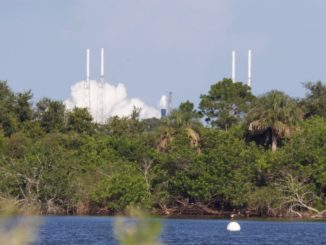
The Dragon spaceship poised for launch Tuesday will carry more than 2.5 tons of equipment for the International Space Station’s six-person crew, making the first U.S. supply delivery to the orbiting research complex since the crash of an Antares cargo rocket in October.
The space station is not in dire need of supplies, but NASA is eager to stock the complex with provisions, spare parts and experiments to keep the outpost and its crew going.
Tuesday’s launch of the SpaceX-owned Dragon supply ship is the fifth operational cargo mission conducted by the Hawthorne, Calif.-based company since 2012. SpaceX has a $1.6 billion contract with NASA covering 12 resupply flights through 2016.
Liftoff of the 208-foot-tall Falcon 9 rocket is set for 6:20:29 a.m. EST (1120:29 GMT) from Cape Canaveral’s Complex 40 launch pad.
If launch occurs on schedule Tuesday, the Dragon supply ship will reach the space station Thursday for capture with the lab’s Canadian-built robotic arm. Once the capsule is attached to the station’s Harmony module, the astronauts will open hatches and begin unpacking the supplies inside.
“SpaceX-5 is carrying up much-needed cargo the orbiting outpost,” said Mike Suffredini, NASA’s space station program manager. “The SpaceX folks have worked really closely with us this time. Of all the cargo on-board, we have about 1.8 metric tons (nearly 4,000 pounds) of pressurized cargo. I think that’s the most we’ve crammed into the Dragon to date.”
NASA says the experiments stowed aboard Dragon will support 256 science and research investigations. The cargo includes supplies to support the planned one-year expedition of Scott Kelly and Mikhail Kornienko on the space station, which begins in late March.
Some of the gear loaded inside the Dragon capsule’s internal cabin will replace equipment lost during the fiery Oct. 28 crash of an Orbital Sciences Corp. Antares rocket at Wallops Island, Va.
NASA has a separate resupply deal with Orbital Sciences to fly cargo to the space station using its commercial Antares launcher and Cygnus spacecraft. The Antares launcher is grounded while engineers redesign the booster with a new engine, and Orbital’s backup plan is to launch a Cygnus logistics freighter on a United Launch Alliance Atlas 5 rocket in late 2015 to continue executing on its cargo contract.
Suffredini said NASA shuffled the Dragon spaceship’s cargo manifest to accommodate items that needed to launch in the wake of the Antares launch failure. The changes included the removal of a high-pressure oxygen tank from the Dragon’s supply load to make room for more urgent cargo.
“That’s been with the help of the SpaceX folks who have used quite a bit of ingenuity to put items into all the little cracks and crevasses as we kind of lean on the Dragon vehicle to supply ISS here for the next little while until the Orbital folks are flying again,” Suffredini said.
Before the Antares failure, space station managers tried to keep the outpost provisioned with food, water, spare parts and other “consumables” at least six months ahead of time. The cushion allowed the station to keep functioning in case the outpost’s fleet of cargo supply vehicles faced delays or other problems.

Suffredini said Monday the six-month protection will now be reduced to around four months in order to keep a steady flow of research experiments going up to the space station.
With the grounding of Orbital’s logistics vehicles and the retirement of the European Space Agency’s Automated Transfer Vehicle — the station’s largest cargo carrier in the post-shuttle era — SpaceX’s Dragon capsule and Russia’s Progress refueling and resupply freighter are the two main supply lines between Earth and the orbiting laboratory.
Japan’s automated H-2 Transfer Vehicle also flies to the space station with supplies, but it only launches about once per year.
The situation puts the success SpaceX’s resupply missions in the critical path to maintaining the space station’s six-person crew and a feverish research schedule aboard the 450-ton outpost circling 250 miles above Earth.
“If something happened to SpaceX, we’d have to figure out where we were and then how quickly they could return to flight, and we would react accordingly,” Suffredini said. “But without your supply ships, you can’t go on indefinitely.”
Hans Koenigsmann, SpaceX’s vice president of mission assurance, said the company’s Falcon 9 and Dragon teams are focused on meeting the space station’s need for supplies, even while engineers conduct experiments on booster flyback and reusability.
“I do expect attention on the first stage maneuvers and landing, but I do want to point out that the main mission is absolutely to get cargo to the station and to make sure that the station supply is steady, stable and reliable,” Koenigsmann said.
The space station could be operated by three crew members if supplies run thin, Suffredini said.
“The crew has enough supplies, including research, to continue to work for somewhere between four and six months, depending on what we did,” Suffredini said. “The decision we’d have to make is how quickly can SpaceX get back up, and then what can we do with our Russian colleagues with regard to any support they might supply … Then we’d have to look together about, ‘OK, what are the right steps to take, do we go ahead and let everybody go home until we’re ready to resupply again or do we step down to three crew.’ I suspect that’s what we’d do if we had to — we’d step down to three crew first.
“The way we manage (the) station is not to have to make those decisions immediately,” Suffredini said. “We have quite a bit of resources on-board. We have quite a bit of time to work through a problem.”
Follow Stephen Clark on Twitter: @StephenClark1.



